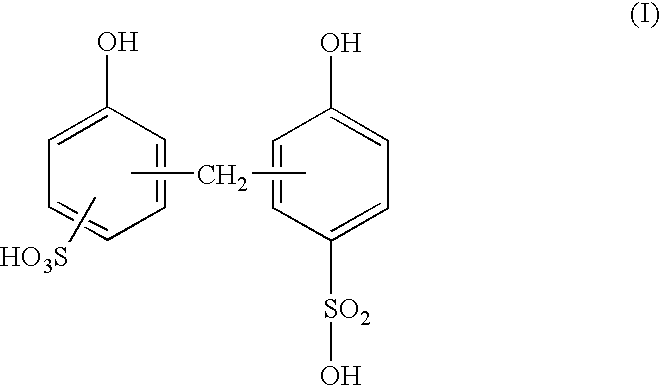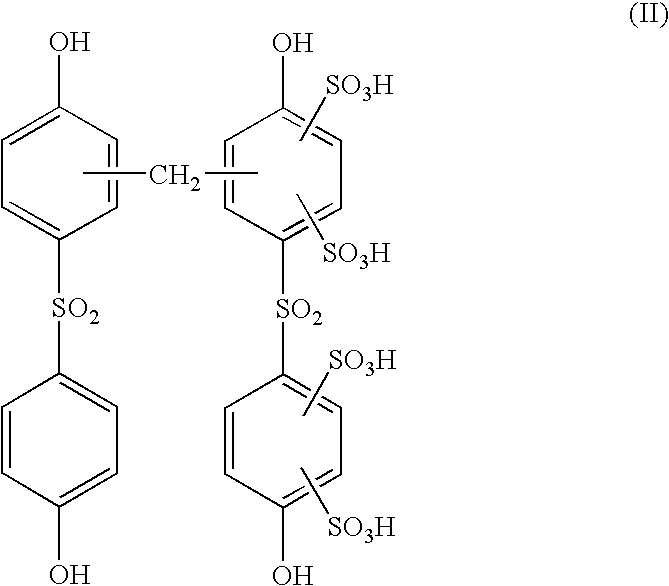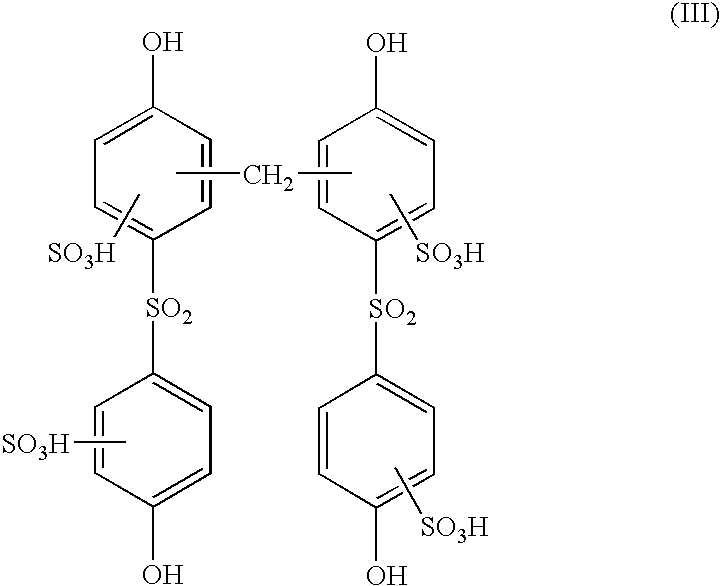Polyamide fiber substrate having stain resistance, composition and method
a polyamide fiber and substrate technology, applied in the direction of fibre chemical features, weaving fabrics, weaving, etc., can solve the problems of high degree of yellowing or discoloration, higher degree of staining, and subsequent discoloration of fibrous polyamide substrates, etc., and achieve the effect of high
Inactive Publication Date: 2007-10-09
TRI TEXCO
View PDF10 Cites 2 Cited by
- Summary
- Abstract
- Description
- Claims
- Application Information
AI Technical Summary
Benefits of technology
[0012]It is an object of this invention to provide fibrous polyamide or wool substrates having durable resistance to staining by acid colorants.
[0014]It is still a further object of this invention to provide an aqueous formulation for providing resistance to staining by acid colorants in a fibrous polyamide or wool substrate.
[0018]In accordance with another aspect of the invention there is provided an aqueous formulation for providing resistance to staining by acid colorants in a fibrous polyamide substrate comprising in an aqueous vehicle: a) a semi-bleached to bleached sulfonated aromatic condensation resin, said resin being selected from the group consisting of condensation products of: i) phenolsulfonic acid, dihydroxydiphenyl sulfone and an aldehyde; ii) sulfonated dihydroxydiphenyl sulfone, dihydroxydiphenyl sulfone and an aldehyde; iii) sulfonated dihydroxy diphenyl sulfone and an aldehyde and iv) mixtures of i), ii) and iii) and b) a semi-soluble methacrylic acid polymer of high weight average molecular weight and high number average molecular weight.
Problems solved by technology
Fibrous polyamide substrates, such as nylon carpeting and similar wool substrates are susceptible to staining by both naturally occurring and commercial acid colorants found in many common foods and beverages.
Improved stain resistance after wet cleaning can be achieved by increasing the amount of the sulfonated hydroxy aromatic formaldehyde condensation products, in the stain resist product or by increasing the amount of stain-resist product initially applied to the substrate, however, this generally leads to discoloration caused by yellowing of the substrate initially and further discoloration upon exposure to oxides of nitrogen and / or light.
It is generally known that increasing the ratio of the dihydroxydiphenyl sulfone to the phenol sulfonic acid or naphthalene sulfonic acid increases the stain resistance properties of the resin and subsequently causes a higher degree of yellowing or discoloration initially and further discoloration upon exposure to oxides of nitrogen and / or light.
Method used
the structure of the environmentally friendly knitted fabric provided by the present invention; figure 2 Flow chart of the yarn wrapping machine for environmentally friendly knitted fabrics and storage devices; image 3 Is the parameter map of the yarn covering machine
View moreImage
Smart Image Click on the blue labels to locate them in the text.
Smart ImageViewing Examples
Examples
Experimental program
Comparison scheme
Effect test
examples
1) Test on Nylon 66
[0099]The treatment bath was adjusted to pH 1.8 by Bartex C-4 (Trademark for buffering system in liquid form of Trichromatic Carpet Inc. under U.S. Pat. No. 5,821,177).
[0100]The amount of stainblocker used were as follow:
example # 1
[0101]4 g / L condensation product #C unbleached manufactured by the Second Method (hereinbefore)
example # 2
[0102]4 g / l condensation product #C bleached manufactured by the Second Method (hereinbefore)
the structure of the environmentally friendly knitted fabric provided by the present invention; figure 2 Flow chart of the yarn wrapping machine for environmentally friendly knitted fabrics and storage devices; image 3 Is the parameter map of the yarn covering machine
Login to View More PUM
| Property | Measurement | Unit |
|---|---|---|
| Fraction | aaaaa | aaaaa |
| Molecular weight | aaaaa | aaaaa |
Login to View More
Abstract
Description
[0001]This application is a continuation of Ser. No. 10 / 099,959, filed Mar. 19, 2002, now U.S. Pat. No. 6,814,881, which is a continuation of Ser. No. 09 / 465,265, filed Dec. 17, 1999, now U.S. Pat. No. 6,395,655.BACKGROUND OF THE INVENTION[0002]i) Field of the Invention[0003]This invention relates to a fibrous polyamide or wool substrate having durable resistance to staining by acid colorants and to a method of rendering a fibrous polyamide or wool substrate durably resistant to staining by acid colorants.[0004]ii) Description of Prior Art[0005]Fibrous polyamide substrates, such as nylon carpeting and similar wool substrates are susceptible to staining by both naturally occurring and commercial acid colorants found in many common foods and beverages. The demand for reduced staining from such acid colorants has by and large been met by treatment with compositions comprising sulfonated naphthol or sulfonated phenol-formaldehyde condensation products as disclosed for example in the fol...
Claims
the structure of the environmentally friendly knitted fabric provided by the present invention; figure 2 Flow chart of the yarn wrapping machine for environmentally friendly knitted fabrics and storage devices; image 3 Is the parameter map of the yarn covering machine
Login to View More Application Information
Patent Timeline
 Login to View More
Login to View More IPC IPC(8): B32B27/30B32B5/02B32B27/04B32B27/12B32B27/34D06M15/263D06M15/41
CPCD06M15/263D06M15/412Y10T428/2938D06M2101/34Y10T442/2279Y10T442/2877Y10T442/2893Y10T442/2582Y10T442/2574Y10T442/2287Y10T428/23986
Inventor ELGARHY, YASSIN M.
Owner TRI TEXCO
Features
- R&D
- Intellectual Property
- Life Sciences
- Materials
- Tech Scout
Why Patsnap Eureka
- Unparalleled Data Quality
- Higher Quality Content
- 60% Fewer Hallucinations
Social media
Patsnap Eureka Blog
Learn More Browse by: Latest US Patents, China's latest patents, Technical Efficacy Thesaurus, Application Domain, Technology Topic, Popular Technical Reports.
© 2025 PatSnap. All rights reserved.Legal|Privacy policy|Modern Slavery Act Transparency Statement|Sitemap|About US| Contact US: help@patsnap.com



